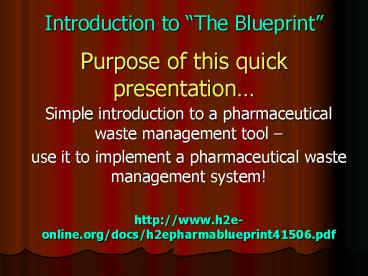Introduction to The Blueprint Purpose of this quick presentation PowerPoint PPT Presentation
1 / 14
Title: Introduction to The Blueprint Purpose of this quick presentation
1
Introduction to The BlueprintPurpose of this
quick presentation
- Simple introduction to a pharmaceutical waste
management tool - use it to implement a pharmaceutical waste
management system! - http//www.h2e-online.org/docs/h2epharmablueprint4
1506.pdf
2
- Managing Pharmaceutical Waste A 10-Step
Blueprint for Health Care Facilities in the
United States - The Blueprint is an H2E document that was funded
by a grant from EPA. It was written by Eydie
Pines and Charlotte Smith.
3
Quick Review of the 10 Steps
- Step 1 Getting Started
- Support from Senior Management
- Develop a Committee
- Plan for opportunities, challenges and financial
implications to making changes, improvements in
your facility.
4
- Step 2 Understanding the Regulations
- Defining Hazardous Wastes
- Listed (F, K, P and U)
- Characteristic
- Ignitability
- Corrosivity
- Reactivity
- Toxicity
- If a waste isnt a listed waste or doesnt
exhibit characteristics of a hazardous waste, it
is considered a solid waste - Generators status depends on types and amounts
of waste generated - Treatment Disposal Options
5
- Step 3 Consider Best Management Practices (BMPs)
for Non-Regulated Pharmaceutical Wastes - RCRA waste regulations not updated in pace with
development of drugs - Recommendations made for how to manage
pharmaceutical waste to protect water bodies,
aquatic species, human health. - Incineration (endocrine disruptors, carcinogenic
drugs, Formulations w/listed active ingredient
that is not the sole active ingredient, etc.) - Eliminate drain disposal
- Avoid Landfilling
- Use non PVC IV Sets
6
- Step 4 Perform a Review of Your Drug Inventory
- Gather Drug-Specific Data national drug code,
brand name, generic name, Mfr, strength, dosage
form, package size - Consider Compounded Items Reformulations
- Obtain purchasing data from Your Drug Wholesaler
7
- Step 5 Minimizing Pharmaceutical Waste
- Consider lifecycle Impacts in Purchasing Process?
- Maximize Use of Opened Chemotherapy Vials
- Implement Samples Policy
- Labeling Drugs for Home Use
- Priming Flushing IV lines w/Saline Solution
- Examine Size of Containers Relative to Use
8
- Step 5 Minimizing Pharmaceutical Waste (contd)
- Replace Prepackaged Unit Dose Liquids
w/Patient-Specific Oral Syringes - Try to eliminate generation of controlled
substances that are also hazardous wastes - Use hard plastic buckets for delivery of
chemotherapy drugs to hospital floors not brown
paper bags - Monitor dating on emergency syringes
- Review inventory controls to minimize outdates?
9
- Step 6 Assess Current Practices
- Conduct Department Reviews
- Conduct Analyses Frequently
- Confirm your Generator Status
10
- Step 7 Taking On Communication/Labeling Challenge
- Automating the Labeling Process
- Manually Labeling in the Pharmacy
- Providing Guidance on the Floor
- Selecting a Message for the Label
- Labeling Drugs further up the food chain
11
- Step 8 Consider Management Options
- Segregation at the Point of Generation
- Centralizing Segregation
- Managing all drug waste as hazardous
12
- Step 9 Getting Ready for Implementation
- Locating Your Satellite Accumulation Areas
- Evaluating Your Storage Accumulation Area
- Selecting the Right Vendors
- Conducting Pilots
- Putting it all together Policies Procedures
- Preparing for Spills
13
- Step 10 Launch the Program
- Educate Train Staff
- Staging the Roll-out
- Paperwork Requirements Filling Out Required
Forms - Hazardous Waste Manifests
- Land Disposal Restrictions
- Tracking, Measuring Recording Progress
14
Use the Blueprint
- Some copies are here and available to you
- You can download the Blueprint at
- http//www.h2e-online.org/docs/h2epharmablueprint
41506.pdf - Mary Dever-Putnam 617-918-1717
- Dever.mary_at_epa.gov

